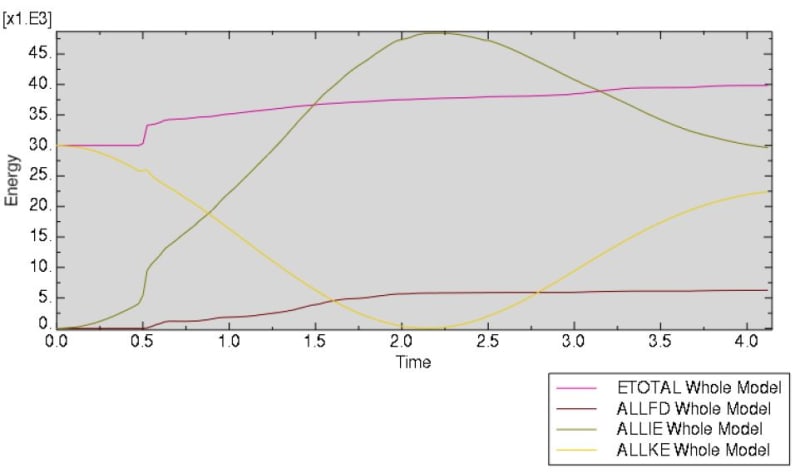Navigation
Install the app
How to install the app on iOS
Follow along with the video below to see how to install our site as a web app on your home screen.
Note: This feature may not be available in some browsers.
More options
Style variation
-
Congratulations cowski on being selected by the Eng-Tips community for having the most helpful posts in the forums last week. Way to Go!
You are using an out of date browser. It may not display this or other websites correctly.
You should upgrade or use an alternative browser.
You should upgrade or use an alternative browser.
Absorbed energy from impact
- Thread starter loyal979
- Start date
- Status
- Not open for further replies.
I guess it's explicit analysis, right ? Then it is good to examine all energies, their ratios and contributions to overall energy. Not only for research purposes but also to make sure there are no undesirable effects. Anyway, to evaluate absorbed energy request ALLPD (plastic dissipation) and ALLKE (kinetic energy).
- Thread starter
- #3
Hey FEA way, Thank you for your help and feedback.
yes, I am doing explicit analysis (impact simulations of composites). I have run a test and requested ALLKE and ALLPD. The ALLPD output is zero. Also, my ETOTAL (total energy) is constant throughout the simulation. What does that mean?
yes, I am doing explicit analysis (impact simulations of composites). I have run a test and requested ALLKE and ALLPD. The ALLPD output is zero. Also, my ETOTAL (total energy) is constant throughout the simulation. What does that mean?
- Thread starter
- #5
Thank you FEA for your help.
So I have performed another simulation and I plotted the energies shown in the attached figure. The total energy is increasing and I am in the final stage of my research and I am kinda panicking from these results.
Any idea why the total energy is increasing and the internal energy is large. Also, I have frictional dissipation energy is large as well.
Is it because the mesh is not fine enough? Or is it because the hourglass effect since I am using C3D8R?
Any suggestions? Thank you in advanced

So I have performed another simulation and I plotted the energies shown in the attached figure. The total energy is increasing and I am in the final stage of my research and I am kinda panicking from these results.
Any idea why the total energy is increasing and the internal energy is large. Also, I have frictional dissipation energy is large as well.
Is it because the mesh is not fine enough? Or is it because the hourglass effect since I am using C3D8R?
Any suggestions? Thank you in advanced

To check for hourglassing compare ALLAE and ALLIE. The first one should be a very small fraction of the second one.
Large changes in ETOTAL are also alarming (they can be caused by exceeding the stable time increment). This total energy should remain approximately constant (not necessarily zero, especially that you probably use initial velocity which results in nonzero initial ETOTAL and positive initial ALLKE). But in this case it's not that bad.
ALLKE vs ALLIE is important but in case of quasi-static analyses where kinetic energy should be very small compared with internal energy. So it needs to be checked when mass scaling is used to make sure it's not too large.
ALLFD is caused by sliding in contact interface.
Large changes in ETOTAL are also alarming (they can be caused by exceeding the stable time increment). This total energy should remain approximately constant (not necessarily zero, especially that you probably use initial velocity which results in nonzero initial ETOTAL and positive initial ALLKE). But in this case it's not that bad.
ALLKE vs ALLIE is important but in case of quasi-static analyses where kinetic energy should be very small compared with internal energy. So it needs to be checked when mass scaling is used to make sure it's not too large.
ALLFD is caused by sliding in contact interface.
- Thread starter
- #7
Thank you FEA way.
If I have my time incrementation type is automatic, it should take care of the stable time increment and adjust it. What confusing me is that I have another model used it in a similar analysis (impact simulation). The only difference is that the mesh in the second model is much finer and the material is different as well. The ETOTAL in the second model (with fine mesh) is approximately constant which gives me confidence in the model. I have generated both models in a similar approach and as I mentioned that the only difference that I could tell is the mesh and material properties.
If I have my time incrementation type is automatic, it should take care of the stable time increment and adjust it. What confusing me is that I have another model used it in a similar analysis (impact simulation). The only difference is that the mesh in the second model is much finer and the material is different as well. The ETOTAL in the second model (with fine mesh) is approximately constant which gives me confidence in the model. I have generated both models in a similar approach and as I mentioned that the only difference that I could tell is the mesh and material properties.
Change in ETOTAL indicates some instability but (since this change is not large) if you carefully perform other standard checks and find no errors then I think that you don't have to worry about it. However, it would be good to refine the mesh in this model as well.
- Status
- Not open for further replies.
Similar threads
- Replies
- 1
- Views
- 1K
- Locked
- Question
- Replies
- 4
- Views
- 343
- Locked
- Question
- Replies
- 3
- Views
- 2K
- Replies
- 3
- Views
- 2K
